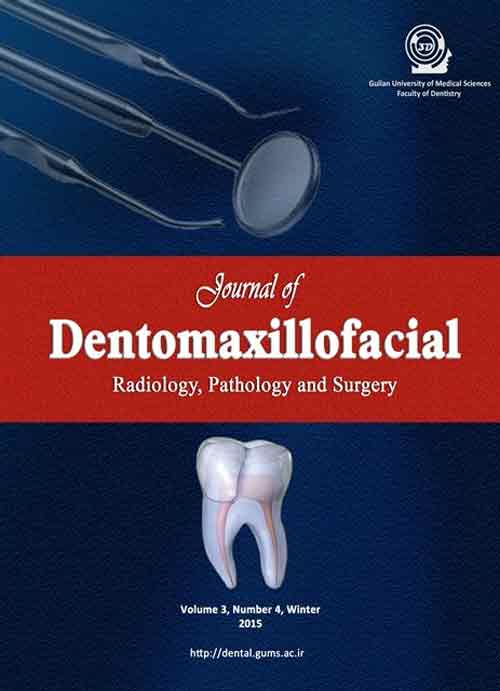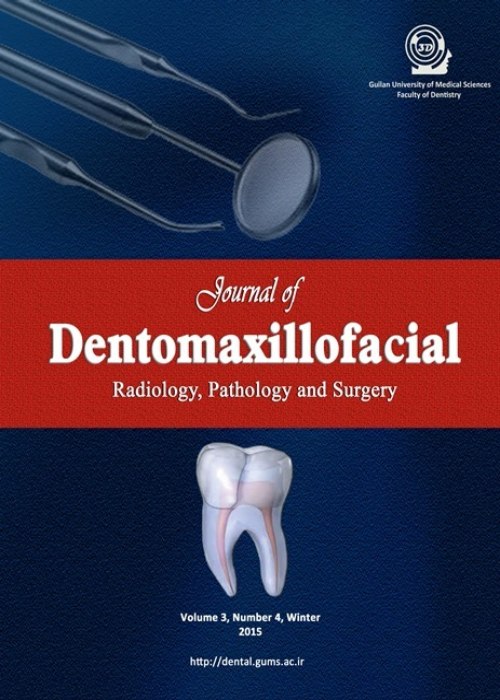فهرست مطالب

Journal of Dentomaxillofacil Radiology, Pathology and Surgery
Volume:6 Issue: 2, Summer 2017
- تاریخ انتشار: 1396/08/28
- تعداد عناوین: 6
-
-
Pages 1-9IntroductionDental maturation is a useful indicator of growth. Moreover, skeletal maturation is assessed by the cervical vertebrae maturation (CVM) stages, using lateral cephalometric radiographs. This study aimed to investigate the association between Demirjians method and CVM stages and also to analyze the diagnostic performance of the dental maturation stages for identification of growth phases in Guilani subjects.Materials And MethodsDigital panoramic and lateral cephalometric radiographs of 200 healthy subjects (73 boys and 127 girls, ranging from 6 to 18 years of age) were examined. Dental maturity was assessed by Demirjians method, whereas skeletal maturity was estimated by the CVM stages. Diagnostic performances were evaluated based on the identification of the growth phases using positive likelihood ratios (LHR). The Spearman rank-order correlation coefficient was used to measure the association between the CVM stages and dental calcification stages.ResultsCorrelation between the dental developmental stages and CVM stages was statistically significant (moderate for males, r = 0.515 and high for females, r = 0.889). Three teeth revealed positive LHRs greater than 10 only for identification of the prepubertal growth phase, with value from 36.46 for second molar (stage E) and 19.75 for canine and first premolar (stage F in both).ConclusionDespite the moderate to high correlation between the dental and skeletal maturity in Guilani subjects, diagnostic performances of the dental maturity for the identification of pubertal growth spurt would be limited. Thus, the second molar (stage E) has the highest diagnostic performance only in the identification of prepubertal phase.Keywords: Tooth, Radiograph, Panoramic, Cervical Vertebrae
-
Pages 10-15IntroductionThe number, size, shape, and structure of teeth in humans show very wide variation among different populations and sometimes within the same population. The aim of the present study was to determine the prevalence of developmental dental anomalies among patients attending the faculty of dentistry in Rasht, Iran over a period of seven months.Materials And MethodsThis cross-sectional study was carried out on 154 dental patients (aged 10 to 30 years) attending dental school in the city of Rasht during 20152016. Patients were examined clinically and radiographically for the presence of dental anomalies. The prevalence of four types and 24 subtypes of dental anomalies were evaluated in this study. Descriptive statistics was performed using SPSS 21, and the value of significance was obtained using the Chi-square test. The significance level was set to a p-value of 0.05.ResultsThe prevalence of dental anomalies was 71.4%, and the prevalence of Carabelli Cusp was 40.3%. The most common anomaly was Talon Cusp (31.8%) followed by Enamel defects (28.5%), Root Dilaceration (26.6%), Dens Invaginatus (16.2%), Hypodontia(8.4%), Microdontia (7.8%), Taurodontism (3.24%), and Hyperdontia (3.2%).ConclusionAnomalies of tooth shape were the most common type of dental anomalies, and size anomalies were the least. Because these anomalies may cause various dental problems, it seems essential to diagnose these anomalies to prevent future problems.Keywords: Tooth Abnormalities, Radiography, Panoramic, Prevalence
-
Pages 16-21IntroductionConsidering the importance of avoiding the outcomes of injury to the inferior alveolar nerve and its accessory branches, the present study was conducted with the purpose of determining the frequency of bifid mandibular canals using cone beam computed tomography images in an Iranian population.Materials And MethodsIn this cross sectional study, 221 CBCT images were evaluated in terms of presence/absence of BMC. In the case of detection of a bifid mandibular canal, the type of bifidity was identified according to the classification of Langlais et al. Furthermore, the relationship between the BMCs and the apices of the third molar teeth was determined based on a classification formerly developed by Correr et al.ResultsAmong the whole 221 CBCT images evaluated, 6 (2.7%) bifid mandibular canals were detected. The bifidity types were as follows: 4 canals with 1U type, 1 canal with 2UR type and 1 canal with 2BC type. Regarding the relationship of the bifid canals with the mandibular third molar teeth, 1 canal was type A, 4 were type B and 1 was related to a patient not having the third molar teeth. Furthermore, no significant relations were found between the presence of BMCs and the patients genders (P = 0.67).ConclusionBMCs did not show a remarkable frequency in our study. However, precise evaluation of the patients radiographic records is mandatory for the detection of BMCs in order to reduce hazardous and unexpected outcomes.Keywords: Cone-Beam Computed Tomography, Mandibular Nerve
-
Pages 22-29IntroductionFacial beauty is becoming more and more important worldwide. This is defined as being close to what is advertised as attractiveness by the media and is determined mainly by golden proportions. This study aimed to observe the soft tissue facial angular and proportional norms of South Iranian population attending Shiraz Dental Schools clinic.Materials And MethodsSeventy subjects (34 males and 36 females; 16 - 30 years of age) with Persian origin who had a skeletal class I pattern and almost well-aligned maxillary and mandibular dental arches who participated in this cross-sectional study were selected from patients attending Shiraz Dental Schools orthodontic clinic in 2013. Standardized frontal facial view digital photographs were taken from subjects and were traced. Four angular and eight proportional facial variables were analyzed using AutoCAD software. For statistical evaluation, a Students t-test was used and the reliability of the method was assessed using Inter-class Correlation Coefficient within a four-week interval.ResultsMen had a higher facial asymmetry, a higher facial Index, a higher proportion of the distance between inner canthus of the eyes divided by the mean of the width of the right and left eyes, and a lower facial aperture modified angle average compared to females.ConclusionThe average measurements of most facial variables of this studys population deviated from the ideal values suggested in texts and from those of the comparison population.Keywords: Esthetics, Photogrammetry, Cosmetic Dentistry
-
Page 30IntroductionDespite similar histopathological features, peripheral giant cell granuloma (PGCG) and central giant cell granuloma (CGCG) differ in their biological behavior. PGCG and CGCG are hemorrhagic/vascular lesions, clinically and microscopically. Angiogenesis is necessary for the growth and development of lesions and affects their clinical behavior. CD105 is a useful vascular marker for assessment of angiogenesis. This study aimed to assess the CD105 expression in PGCG and CGCG by immunohistochemistry in order to determine angiogenesis in these lesions.Materials And MethodsA total of 30 PGCG and 30 CGCG specimens were stained for CD105 marker. The expression of this marker and the angiogenic potential of lesions were determined by calculating the mean vascular density (MVD).ResultsAll specimens revealed immunostaining of CD105 marker. MVD was 26.56 ± 11.03 in PGCG and 22.32 ± 12.81 in CGCG. Herein, the two groups did not differ significantly (P = 0.390).ConclusionThis study demonstrated neovascularization in PGCG and CGCG. The angiogenic potential between the two groups did not significantly differ. This finding may suggest that the distinct clinical behavior of PGCG and CGCG is independent of the number of vessels and angiogenesis.Keywords: Neovascularization, Pathologic, Granuloma, Giant Cell, Immunohistochemistry, Endoglin
-
Page 37Hemifacial microsomia is a rare congenital malformation of craniofacial structures. Its characteristic features are unilateral underdevelopment of the
face and ear malformations. This study describes clinical and radiographical features of a rare case of a 4-year-old hemifacial microsomia patient with underdevelopment of the left side of the face and preauricular skin tags on the affected side. Management of these patients requires a multidisciplinary
approach to provide the most effective and appropriate treatment.
Keywords: Hemifacial microsomia, Facial asymmetry, Congenital abnormalities


